|
|
|
|
|
|
|
|
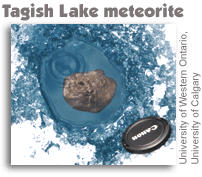
|
Tagish Lake -- A Meteorite from the Far Reaches of the Asteroid Belt
Written by David W. Mittlefehldt |
Every year, the Earth is pelted by debris that occupies the void between the planets. This debris is mostly dust- to sand-sized rocky bits shed by comets or asteroids. You, dear web-surfer, may have witnessed the recent spectacular Leonid meteor shower. This occurs when the Earth plows through dust expelled from comet Temple-Tuttle as it travels through the inner solar system -- in 2002 we went through a particularly concentrated dust tail, resulting in the excellent Leonid display. However, these grains burn-up in the upper atmosphere and don't reach the ground as meteorites. A rarer event is a bright fireball streaking across the sky. These sometimes result in the recovery of meteorites that can be studied by scientists to uncover the secrets of the solar system. A recent example of this is the fall of the Peekskill meteorite in 1992 [Data link from Mineralogical Database]. This spectacular fireball was witnessed by thousands as it streaked northeast across the skies of the Mid-Atlantic States, before smashing into the trunk of a parked car in Peekskill, New York. The Peekskill meteorite is of a type known as an ordinary chondrite. As the name implies, this is a very common type of meteorite. It is still an important object for scientific study, but because it is a common type of meteorite, it adds only incrementally to our understanding of the formation of the solar system.
A much rarer event is the very bright fireball that promises an especially large meteorite, and it is a very rare event indeed when this promised behemoth turns out to be an unusual type of meteorite. Such an event occurred at local dawn on January 18, 2000 over the skies of Alaska, the Northwest and Yukon territories, and British Columbia. This was the fall of the Tagish Lake meteorite. Entering the atmosphere over the Canadian Arctic, the fireball was detected by down-looking US satellites tasked to look for such mundane man-made events as ICBM launches. Traveling south-southeast, the exceptionally bright fireball was witnessed by numerous observers. Why they were out at dawn on a cold winter's day is simply beyond my comprehension.
The Tagish Lake fireball was detected by a wide variety of sensors. Infrared and optical sensors on the satellites detected the light output of the fireball, while infrasound detectors and seismographs picked up the airwaves generated by the meteor. From these data, Peter Brown of the University of Western Ontario and his colleagues were able to estimate the size of the object that hit the Earth's atmosphere, and how much energy was released during its passage. They calculated that the rock initially was about 4 meters in diameter with a mass of about 56 metric tons. The meteor was fragmented several times between 50 and 30 kilometers altitude while plowing through the atmosphere, and heavily ablated until terminal velocity was reached at an altitude of about 28 km. Brown and colleagues estimate that at this point, only about 1.3 metric tons of rock remained -- 97% of the rock had simply burned-up in the atmosphere! All told, the fireball released about 1.7 kilotons of energy. This is about 1/12 the energy of the first atomic bomb.
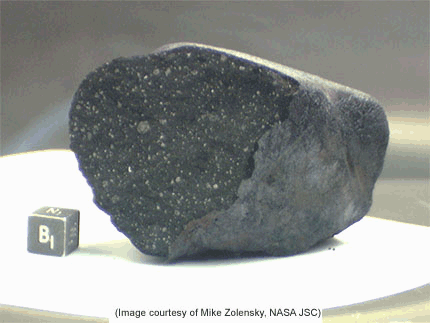 |
The largest Tagish Lake stone, originally massing 159 grams. It has been broken open to show the gross texture of the meteorite. The right side of the stone shows the fusion crust formed by melting of the surface by friction with the atmosphere as it fell. The cube is 1 cm across. |
Only about 0.1% of the estimated 1.3 metric tons of surviving rock was ever recovered. This is only 0.002% of the estimated mass of rock that entered the atmosphere! Had the meteor arrived in July, it is almost certain we would never have found any of the fragments that reached the surface.
A Meteorite's Orbit
Eye witnesses to the fireball were able to provide scientists with sufficiently detailed accounts to permit an orbit to be calculated for the meteor. The calculation done by Peter Brown and his colleagues shows that the pre-entry orbit of Tagish Lake extended all the way from the outer reaches of the asteroid belt to just inside the orbit of the Earth.
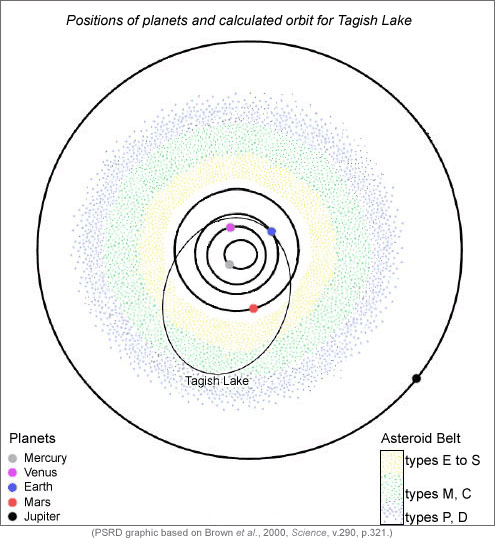 |
Orbital diagram for the inner solar system showing the pre-entry orbit of Tagish Lake, and the asteroid belt. The planets are shown in their positions at the time of fall at 16:43 UT on January 18, 2000. |
Scientists know that most meteorites originate on asteroids, but including Tagish Lake, only five meteorites have known pre-entry orbits. Peter Brown and friends noted that the orbit of Tagish Lake extended to that part of the asteroid belt where asteroids classified by astronomers as C, P and D types predominate. These asteroids are know to have hydrated silicates (water-bearing minerals) on their surfaces, and because of their dark color, are suspected to be rich in carbon compounds. These are also characteristics of the most primitive meteorite types known -- the carbonaceous chondrites, especially the types classified as CI and CM. This was the first clue that Tagish Lake might be a primitive type of chondrite.
However, too much could be read into the significance of the orbit. Getting a meteoroid from the asteroid belt to the Earth is a two-stage process. First, an impact on the parent asteroid is needed to "liberate" bits of rock and boost them off the asteroid into their own orbits. Then the meteoroids have to have their orbits altered. This is most commonly done through gravitational interactions with massive Jupiter. The gravitational tug by Jupiter can, over time, change the paths of meteoroids and asteroids that are in certain orbits, sending some of them into the inner regions of the solar system. Thus, the pre-entry orbit of a meteor may not accurately reflect the location of its parent asteroid. This is where the work by Takahiro Hiroi of Brown University and his colleagues came into play. These scientists measured the spectrum of light reflected by samples of the Tagish Lake meteorite, and compared these results to telescopic spectra of various types of asteroids. They found a good match with the D-type asteroids of the outer regions of the asteroid belt, suggesting that Tagish Lake may be a sample of this type of asteroid.
At this point, the meteoriticists got into the game. Samples of Tagish Lake were distributed to several researchers for mineralogical, petrological and chemical characterization. Studies led by Mike Zolensky at NASA's Johnson Space Center provided a detailed mineralogical and petrological look at Tagish Lake. And what a surprise this meteorite turned out to be! Although it does show some similarities to the two most primitive carbonaceous chondrite types (the CI and CM chondrites) it is nevertheless quite distinct from either of them. In order to better understand the significance of Tagish Lake, let's digress a bit and talk about chondrite petrology in general, and what it tells us.
Chondrites are firstly classified by composition, and then by their texture and mineralogy -- that is, their petrology. The different chemical classifications are given letter designations (for example, CI, CM), while the petrologic divisions within the chemical classes are give numerical designations 1 through 7. Now, this may seem odd, but the texturally most primitive chondrites are type 3. These are composed of chondrules, fine-grained matrix, metal and sulfide. Chondrules are mm-sized spherical rocky beads that were formed by partial to complete melting of clumps of silicate mineral dust in solar nebula -- I like to call these clumps "nebular dust-bunnies." Chondrite types 4 through 7 were formed by increasing dry heating of primitive material resulting in increasing amounts of recrystallization of it. In type 7, the chondrules are no longer recognizable and all fine-grained matrix material has been destroyed. They retain their original minerals, but the original texture cannot be discerned. These chondrites have the texture of high-grade metamorphic rocks found on Earth.
Types 2 and 1 chondrites are formed by increasing degrees of low temperature alteration in the presence of water, with type 1 chondrites being the most altered. Here, the original textures are quite often well preserved, but the original high temperature silicate minerals have been replaced by low temperature silicate minerals containing water, carbonate minerals, plus other phases. In many ways, these chondrites are similar in texture to sea-floor rocks on Earth that have been altered by interaction with ocean water circulating through them. The original texture is quite often clearly preserved even though all the original minerals have been replaced. This is known as pseudomorphic replacement.
One final bit of information will help us understand the significance of Tagish Lake. Although meteoriticists know that chondrules were formed by melting pre-existing nebular dust-bunnies, we really don't know what heat source accomplished this. We do have several hypotheses, however, and all of them have one thing in common -- they should all be more effective closer to the sun than farther away. Thus, we expect that chondrules would have been more abundant close in by the early sun, and unmelted dust-bunnies farther out.
Now back to Tagish Lake. Mike Zolensky and friends found that Tagish Lake is actually composed of two somewhat different rock types. The major difference between the two lithologies is in the abundance of carbonate minerals, one is poor in carbonates and the other is rich in them (see the images below). Both are composed of low temperature minerals pseudomorphing original high temperature phases, but some residual high temperature minerals are nevertheless preserved. This leads to a petrologic classification of type 2. However, Zolensky and company noted that Tagish Lake contained relatively few pseudomorphed chondrules -- much less than in the other type 2 chondrites, the CM2 and CR2 chondrites. They also noted that Tagish Lake has a much lower density than any other type of chondrite. They posited that Tagish Lake was formed further out in the solar system where fewer chondrules were formed and so was composed of a higher proportion of low density matrix material.
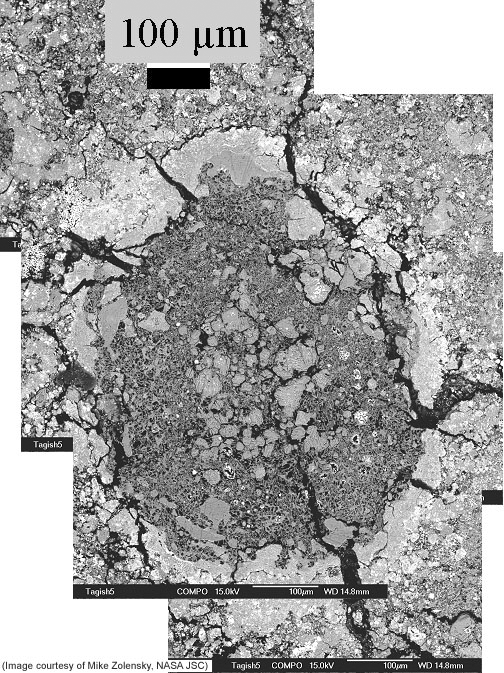 |
A back-scattered electron image of the carbonate-poor lithology showing one of the rare, pseudomorphed chondrules. Almost none of the original high-temperature minerals are left in the chondrule, but the original texture is well preserved. Very few of the mineral grains in this lithology are carbonates. The scale bar is 100 micrometers. |
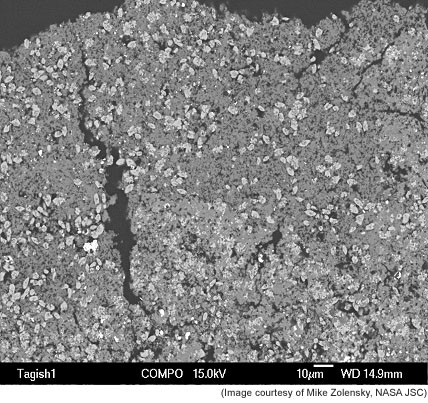 |
A back-scattered electron image of the carbonate-rich lithology showing its typical texture. The abundant light gray grains are carbonate minerals. The scale bar (lower right) is 10 micrometers. |
Well, we now know that Tagish Lake is a petrologic type 2 chondrite, but to which chemical class does it belong? The chemical classes are defined primarily by characteristic features of the bulk composition plus the isotopic composition of oxygen. Oxygen is the third most abundant element in the solar system, after H and He. Thus, it may come as some surprise that the oxygen isotopic composition of the solar nebula was not everywhere the same. About thirty years ago, Robert Clayton of the University of Chicago and colleagues showed that different fractions of the Allende carbonaceous chondrite had distinct oxygen isotopic compositions that demonstrated this heterogeneity. In a series of subsequent publications, Clayton and colleagues showed that many meteorite classes have their own distinctive oxygen compositions. Now days, whenever an unusual meteorite falls or is found, its oxygen isotopic composition is determined to see how it fits in the solar pantheon. Brown and colleagues presented analyses of the oxygen isotopic composition of two bulk samples of Tagish Lake. They found that it is distinct from any other chondrite class, although it is close in oxygen isotopic composition to the primitive CI chondrites. Thus, Tagish Lake seemed to represent a new type of chondrite. This is borne-out by other compositional studies.
Several research groups have done bulk elemental composition studies of Tagish Lake -- Brown and colleagues, Friedrich and colleagues at Purdue University, and me, your humble narrator. The bulk elemental compositions of chondrites record the fractionation processes that occurred during formation of the rocky matter in the solar system. At the start, the solar nebula was composed of a cloud of gas and dust. As formation of the solar system started, gravitational attraction caused the cloud to begin to collapse to form the proto-sun. This collapse heated the cloud to the point that the dust in the inner regions vaporized. Subsequently, the gas cloud cooled, and minerals began to condense out of the gas phase much the way snowflakes condense from the water vapor contained in Earth's atmosphere. This process led to fractionations -- that is separations -- of some elements relative to others based on the minerals they condense into. Different chemical classes of chondrites show differing types and degrees of these fractionations.
Geochemists divide elements into four basic types. Lithophile elements are those that are contained primarily in silicate minerals -- the rocky bits of meteorites. Siderophile elements are found mostly in the iron metal phase. Chalcophile elements follow sulfur into the sulfide minerals. Finally, atmophile elements remain largely in the gas phase. Different silicate minerals, metal and sulfide minerals condense out of the solar nebula at different temperatures. If some process separates minerals from the gas phase before condensation is complete, elemental fractions occur and these can be preserved in chondritic meteorites. The CI chondrites are nearly unfractionated relative to the bulk matter of the solar system. For a wide range of lithophile, siderophile and chalcophile elements, CI chondrites are very similar in composition to the solar photosphere (the visible "surface" of the sun). Since the sun contains about 99.9% of the mass of the solar system, its composition is effectively that of the solar system. Thus, it appears that the CI chondrites acquired all but the atmophile elements in the same proportions as in the primitive solar nebula.
The bulk composition of Tagish Lake is shown compared to CI and CM chondrites in the abundance diagram shown below. The CI chondrites are shown as a straight line because I have normalized the data to CI chondrites -- that is, I divided the concentration of each element in each meteorite type by its concentration in CI chondrites. (I also did a double normalization to magnesium in each meteorite type. This corrects for differing degrees of dilution by volatile constituents in the rocks -- water and carbon dioxide.) The elements are ordered by decreasing temperature at which each element is calculated to have condensed out of the gas phase in the solar nebula, and I have used different shading for lithophile, siderophile and chalcophile elements. Tagish Lake is closest in composition to CI and CM chondrites, but as can be seen, it matches neither of these chondrite types exactly. For those elements that condense above about 1340 K (about 1067 oC, or 1953 oF), Tagish Lake is a good match for CM chondrites. However, for elements that condensed below about 1080 K (about 807 oC, or 1485 oF), Tagish Lake lies between the CI and CM chondrites. This is true independent of whether the element is lithophile, siderophile or chalcophile in character. Here again, the bulk composition shows that Tagish Lake is its own beast, although it is closer to CM chondrites in composition.
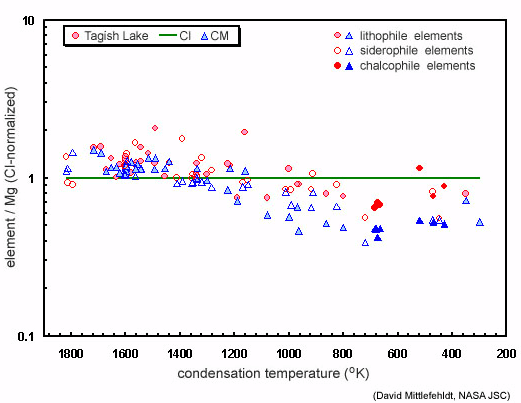 |
A plot of the abundances of a wide range of elements in Tagish Lake compared to the primitive carbonaceous chondrite types CI and CM. Each symbol represents a different element, and they are shaded according to geochemical behavior -- lithophile, siderophile and chalcophile. The elements are plotted according to the temperature at which they are calculated to condense out of the nebular gas into mineral phases. For the more volatile elements (those on the right) Tagish Lake is between CI and CM chondrites in composition. |
Monica Grady of the Natural History Museum in London and her colleagues did detailed analyses for carbon and nitrogen in Tagish Lake, and made estimates of the various light-element components in the meteorite. First off, they found that Tagish Lake contains by far more total carbon than either CI or CM chondrites. However, they studied only a small chip of the meteorite, and they estimated that between 22% and 47% of the carbon was derived from carbonate minerals. It is possible that their sample was of the minor, carbonate-rich lithology identified by Zolensky and friends, in which case the C content determined by Grady and colleagues may overestimate the true abundance. A large fraction of the total carbon is contained in organic molecules -- Grady and company estimate that about 44% of the C is so contained. Currently it is believed that organic compounds in primitive meteorites either are compounds formed in the interstellar medium, or remnants of those compounds modified during alteration on asteroids. Either way, the presence of abundant organic material in Tagish Lake implies that a portion of the material that went into forming its parent asteroid was never strongly heated in the nascent solar nebula. Finally, Grady and colleagues noted that a portion of the carbon is contained in what are called nanodiamonds -- very tiny diamond grains at most only a few micrometers in size. In fact, Tagish Lake contains more of the nanodiamonds than any other meteorite. Nanodiamonds are believed to have formed in the expanding shell of a type II supernova. Hence, they are literally the dust of other stars that traveled through the interstellar medium to end up in our forming solar system. Again, because Tagish Lake contains more of these grains of stardust, it seems likely that this meteorite was formed farther out in the solar nebula than other meteorite types.
The emerging picture, then, is that Tagish Lake represents a new type of primitive meteorite, similar to, but distinct from the CI and CM chondrites. In some properties Tagish Lake is more similar to CI chondrites, in others to CM chondrites. The early studies discussed above point out numerous characteristics of Tagish Lake that suggest that it came to us from the outer reaches of the asteroid belt -- a reflectance spectrum like the distant D asteroids, high carbon and water contents, abundant interstellar nanodiamonds and organic molecules, the low density and low abundance of chondrules -- all bespeak an origin far from the sun. Without doubt, further study of this unique stone will tell much about the events that transpired roughly 4.56 billion years ago that ultimately led to us, sitting in front of our computers, wondering how it all came to be.
|
|
[ About PSRD |
Archive |
Search |
Subscribe ] [ Glossary | General Resources | Comments | Top of page ] |